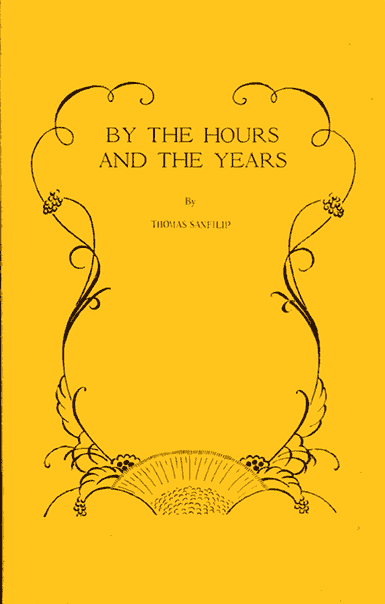
By the Hours and the Years
Thomas Sanfilip
ISBN 0-8283-1538-8
27 pages
Paperback - First Edition (1974) - Branden Press
Price: $20.00
Fall, 1974
Interphase (Fall, 1974)
By the Hours and the Years by Thomas Sanfilip is a story of sentimental love-keeping after love has gone. It is a chronological farewell to the “good old days” of enchanted romance. The verse runs simply and powerfully through the liberal use of imagery wherein the book shows up as a collection of fragments of the mind. But never losing confidence, the poetry brings out the many-layered emotions of youth at the turn of adulthood.
What could easily have drifted into hackneyed prose statements of lost affection have become powerful supplications to self. Reflections on love sets the stage for a tonal poem of varying degrees of sentiment. Sanfilip’s ultimate love is life, but he heeds the wisdom of his perceptions.
I have remained faithful
To the dance, the worship,
The eternity laid in the sediment
of thinking childhood.
Sanfilip’s uniqueness and accessibility arise from the fact that he loves to counterpoint his aphorisms with the sharp, stinging revelations of life’s importance. His double-barreled pen picks out the strong and dispenses with the weak. Joy finally overcomes suffering, anticipation overcomes disappointment and longing.
Leave the dead moment, my friend,
walk on and depart.
He bears down when he observes the lowly and misdirected, with no remorse, but hope. He wants to hear the true caller of happiness, and he’ll go to any lengths with his own perceptions to create it; but because he is able to juxtapose the scene with the idea, the resolution is apparent.
Sanfilip’s poetics seem to infiltrate the basic premises of man’s hostility toward man, his self-deception, jealousy and envy and gives them viability through his utter disregard, for negativism.
He is the one poet I have read who will intentionally remove himself from adverse circumstances in order to achieve a merger of the objective and subjective worlds vis-à-vis his own feelings and ideas of the world. The reader is immersed in his growth. The images are sharp or vague according to Sanfilip’s interpretations of the moment. We are given immediate clues to his awareness, his perception. He is, therefore, not the kind of poet who will toy with symbols or assemble dense conundrums.
In By the Hours and the Years, he is willing abort any well-conceived plan as long as another is more well-conceived. He emerges from his problems the new man, and gives us a new insight into the inner core of a young man’s most embittered and cherished moments, and makes us look at ourselves in a less muddled and confused way, and then realizing he has passed this way before, feeds his own yearning and is finally “Off, into the hunt!”
Jean's Journal (Feb. 1974)
These romantic verses are sensitive to the nuances of words. They produce a mood of honest and relevant meditation on love—its possession and its loss. It is sensuous, reaching the reader on an emotional level, yet it expresses courage and anticipation of a brighter future.
Shubhrangshu Sengupta (Amazon, April, 2005)
Thomas Sanfilip is a poet for people who tend to close their eyes and imagine themselves drifting away to a peaceful afternoon in some exotic location. A quite similar style exists in Sherod Santos’ poetry, too, but I personally feel that Sanfilip just knows when to use rhyming and when not to. This book is a must buy.
